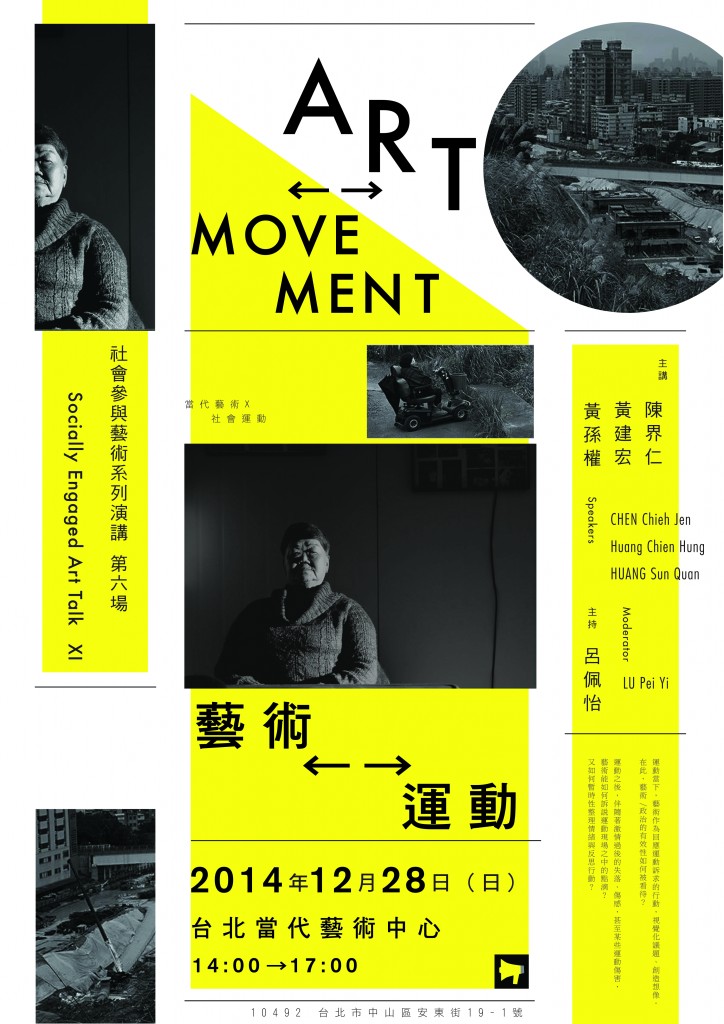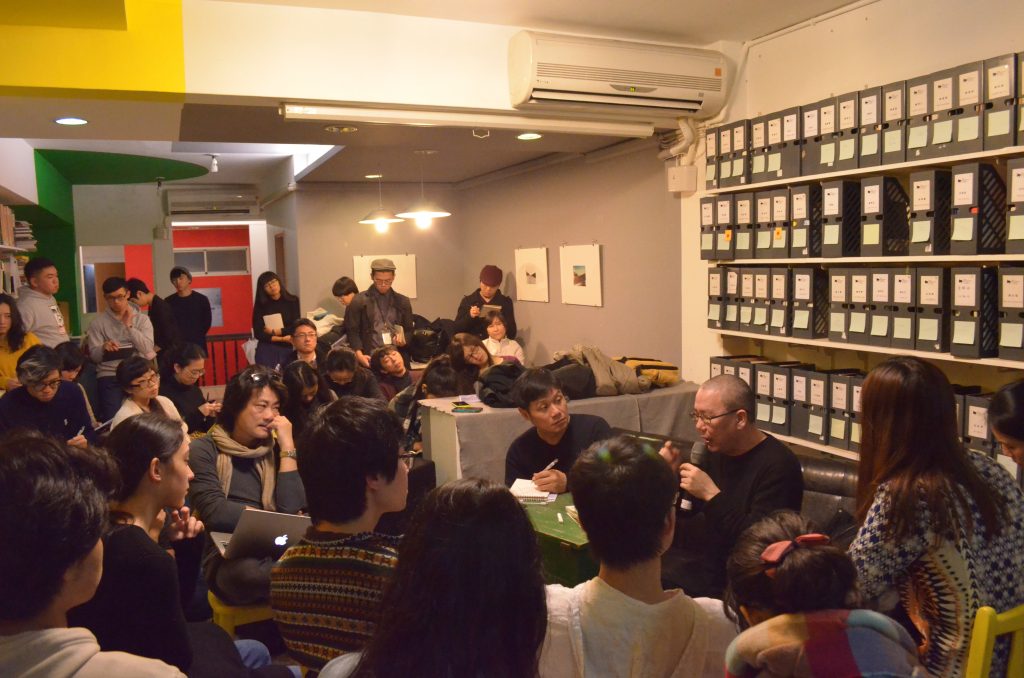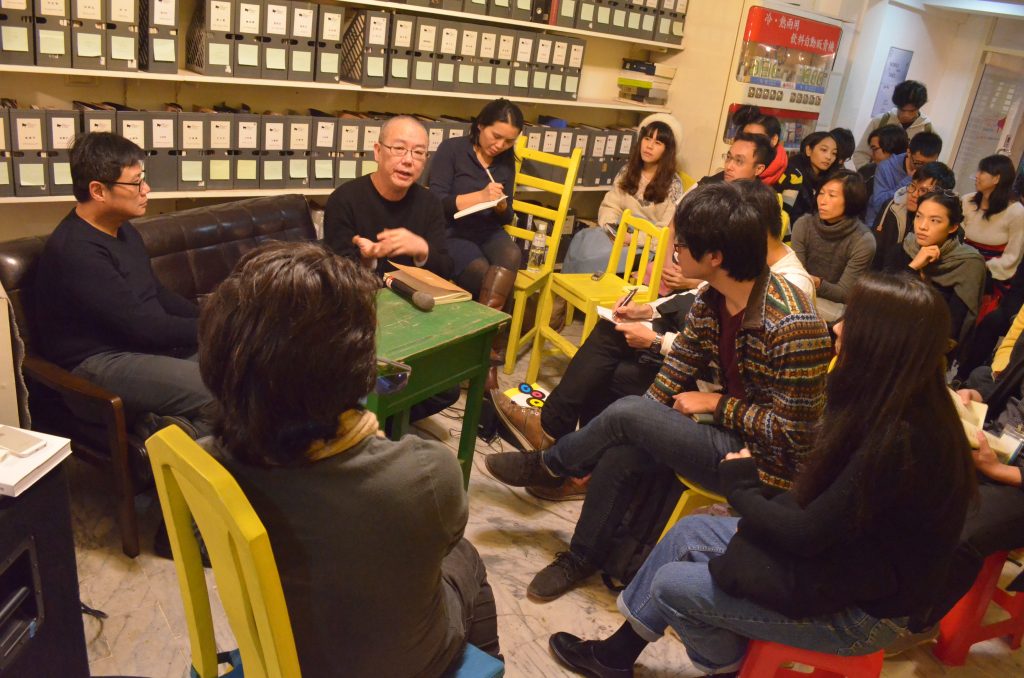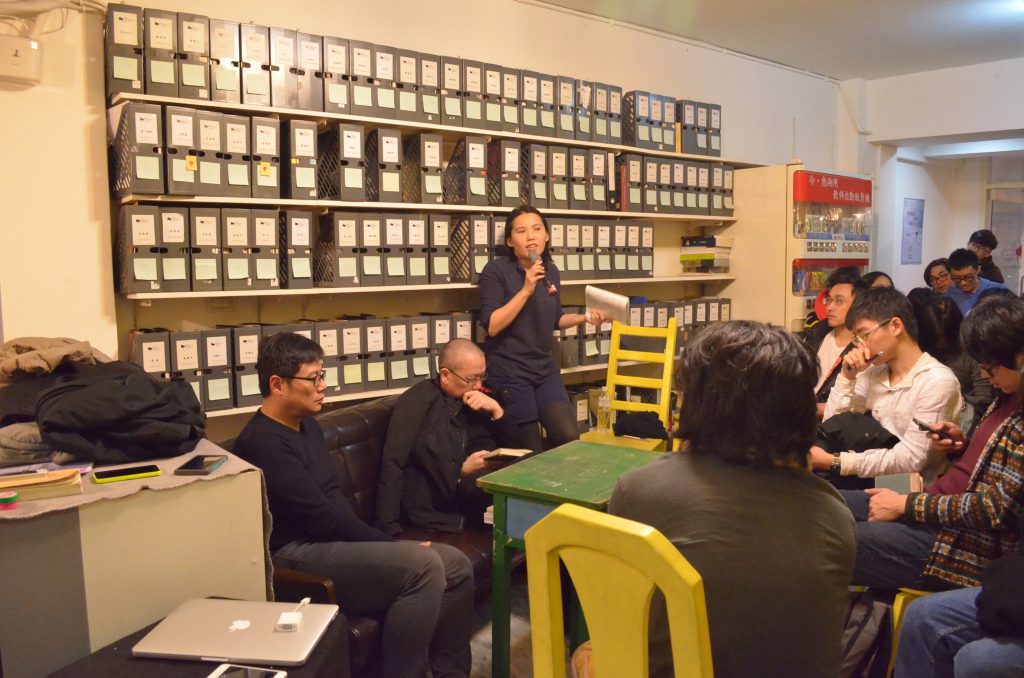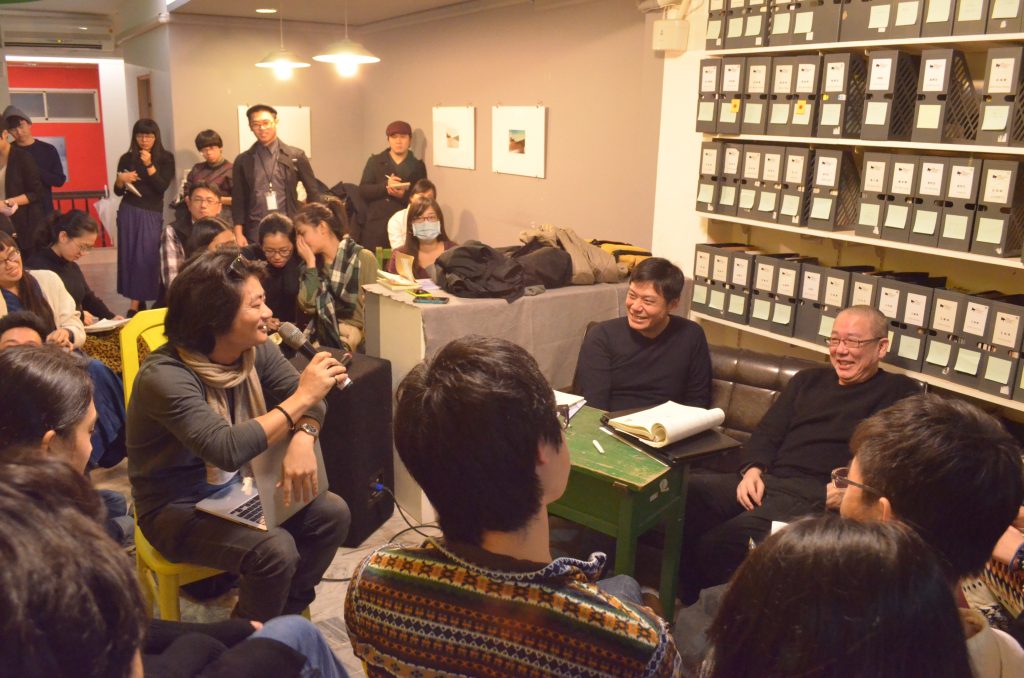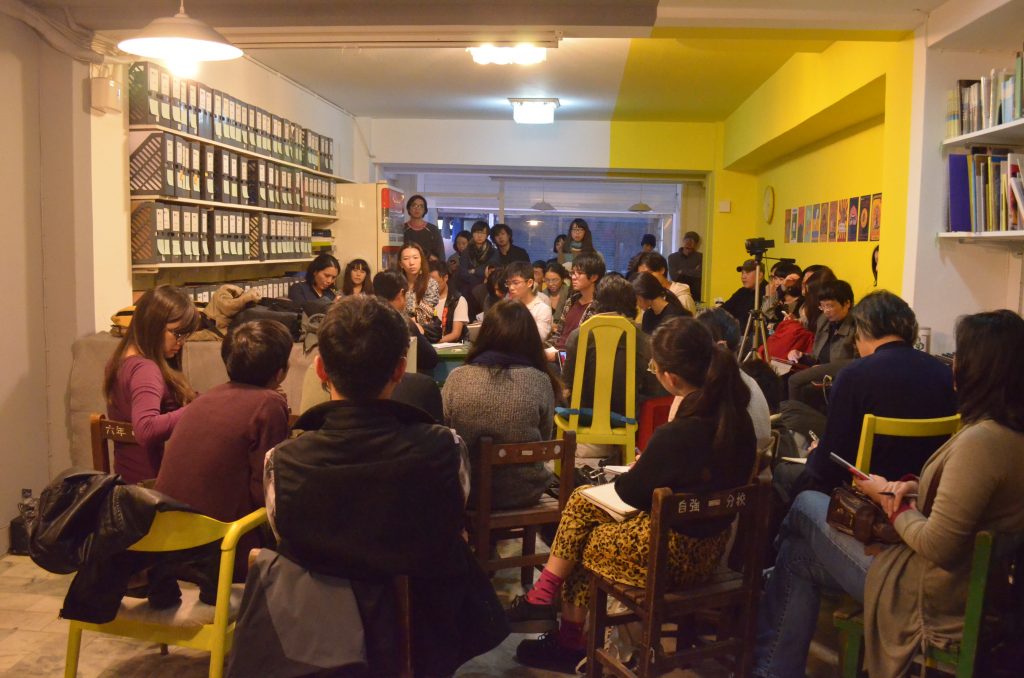社會參與藝術系列演講六「藝術←→運動」
Socially Engaged Art Talk XI “Art←→Movement”
主持:呂佩怡 ︱ 講者:陳界仁、黃孫權、黃建宏
Moderator: LU Pei Yi︱ Speakers: CHEN Chieh Jen, HUANG Sun Quan, HUANG Chen Hung
For English please scroll down.
社會參與藝術系列演講
09.20 【學者專題演講】小泉元宏〈參與式藝術計畫和它在藝術政策中的困境:日本案例〉
10.10 【學者專題演講】鄭波〈溜出金字塔:新公共藝術在中國的歷史與現實〉
10.11 【新書發表】姚瑞中〈海市蜃樓四新書發表會〉
12.07 【圓桌會談】丁穎茵、黃小燕〈與社會交往的藝術—香港台灣交流展〉12.19 【藝術家對談】黃博志、高俊宏〈藝術家的異地創作與社群聯結 〉
12.21 【特別加映場】馬可.丹尼爾博士〈後參與〉
12.28 【藝術家對談】陳界仁、黃孫權、黃建宏〈藝術←→運動〉
社會參與藝術系列強調人的主體性與能動性,認為人類的作為一方面帶來進步的生活,但另一方面也造成環境社會的浩劫,這些惡果必須由人來解決。社會參與藝術(socially-engaged art, participatory art或 social practice)以藝術為施力點,透過人與人之間的合作、參與、聯結、關係建立,讓議題被感知,興起一股「讓我們一起做些甚麼」的想法。此系列將透過幾種不同形式來檢視藝術與社會的關係:【學者專題演講】提供不同地域在社會參與藝術經驗與困境,包括日本、中國、法國等。【藝術家對談】讓藝術家分享其跨地域的社會參與創作經驗。【圓桌論壇】以及【新書發表】等。
藝術←→運動
2014年台港兩地接力守護民主,春天有台灣的太陽花學運,秋冬出現香港的雨傘革命。在這兩次運動中,藝術扮演前所未有的重要角色。當代藝術與社會運動(藝術←→運動)在兩個不同方向的箭頭間可能產生/生產哪些不同的關係?在社會運動的發展時間軸線裡,藝術與運動如何彼此滋養、相互為用、甚至互為主體?
社會參與藝術系列演講第六場,也是最後一場,邀請到黃孫權、黃建宏、陳界仁進行年末大亂鬥,三位講者分別代表「藝術←→運動」不同時間點的思考與狀態。
運動當下,藝術作為回應運動訴求的行動,視覺化議題、創造想像。在此,藝術/ 政治的有效性如何被看待?
運動之後,伴隨著激情過後的失落、傷感,甚至某些運動傷害,藝術能如何訴說運動現場之中的點滴?又如何暫時性整理情緒與反思行動?
當運動遠離很久之後,善於遺忘的島民們早已在日常生活中繼續地被消耗殆盡,這時藝術又有何種力量引發運動的後延性?揭露運動過程被遮蔽的多種聲音?轉化現實,作為運動的某種迴盪?重新喚醒被遺忘的過去,或再給予運動另一個視角的故事?
陳界仁
1960年生於臺灣桃園,目前生活和工作於臺灣臺北。在冷戰/反共/戒嚴時期,陳界仁曾以遊擊式的行為藝術干擾當時的戒嚴體制,1987年解除戒嚴後,曾停止創作八年。1996年重新恢復創作後,開始和失業勞工、臨時工、移工、外籍配偶、無業青年、社會運動者等進行合作,並通過佔據資方廠房、潛入法律禁區、運用廢棄物搭建虛構場景等行動,對已被新自由主義層層遮蔽的人民歷史與當代現實,提出另一種「再-想像」、「再-敘事」、「再-書寫」與「再-連結」的拍攝計畫。其作品曾個展於:盧森堡現代美術館、臺北市立美術館、馬德里蘇菲雅皇后國家美術館、巴黎網球場國家畫廊等機構。
黃孫權
高師大跨領域藝術研究所助理教授,研究專長包含建築與空間理論、文化與媒體、社會運動與跨領域藝術,香港嶺南大學(2005)和中國美院(2013)客座,前《破報》總編輯。曾參與多項社會運動,在高雄成立「搗蛋藝術基地」,籌劃以田野調查為基礎的展覽,如《覹空間》(2012)、高美館的《侯淑姿個展 ─ 望向彼方亞洲新娘之歌》(2010)、高雄勞工博物館《跨國候鳥在台灣》(2011)、旗津貝殼館的《複島》等。著有《綠色推土機》,譯有《自己幹文化-英國九零年代的派對與革命》。
黃建宏
現職國立臺北藝術大學藝術跨域研究所副教授,從事關於影像與策展的研究。同時也書寫電影、當代藝術與表演藝術的評論。並從事法國當代理論,如德勒茲(Gilles Deleuze)、布希亞(Jean Baudrillard)與洪席耶等人著作的翻譯。著作有2009年的《COQ》、2010年的《一種獨立論述》、2011年的《EMU》、2013年的《蒙太奇的微笑》,與董冰峰、朱朱、杜慶春合編《從電影看》譯文論集、後藤繁雄合編《渾變》。於2007年開始接觸策展,國美館線上展覽《Ex-ception》、2009年的《S-HOMO》、2009年九月展出的《後地方 :post.o》、2010年與中國OCAT合作策展《從電影看》,以及2011年的《渾變》交流展、視盟藝博會《日光浴》 特展。 並於2012年規劃Chim↑Pom《美麗世界:倖存之舞》與《心動EMU》特展、2013《臺灣分裂2.0》、《NG的羅曼史》 、2014《運動之後:穆勒咖啡之夜》 。
何冠朋/側記
當時序進入冬末,一年將盡,回數今年的大小事,躍入腦海
首先,由黃孫權老師首開發表,以運動過後的歷史洪流如何
接著由黃建宏老師接棒,主要的著眼點放在運動過後藝術如
最後由陳界仁老師壓軸登場,鏗鏘有力的點出運動應具備實
講座在主持人與陳界仁老師一來一往的討論本次講座的標題
Socially Engaged Art Talks
09.20 Speech—Dr. Motohiro Koizumi, Socially Engaged Art Projects and ItsDilemmas in Arts Policy
10.10 Speech—Dr. Zheng Bo, Socially Deserting the Pyramid: Socially Engaged Art in China
10.11 Book Launch—Yao Jui Chung
12.07 Forum—TING Wing Yan Vivian, Phoebe Wang, Socially Engaged Art in Hong Kong
12.19 Artists’ Talk—Huang Po Chih, Kao Jun Honn, Artist’s Productions in Foreign and Community Bonding
12.21 Special Feature—Dr. Marco Daniel, Post Participation
12.28 Artists’ Talk—Chen Chieh Jen, Huang Sun Quan, HUANG Chien Hung, Art←→Movement
The series of Socially Engaged Art Talks emphasizes on the subjective and initiative of human being. It suggests that as human being making progress in daily life it also causes inevitably crisis to endanger the environment and our society. These consequences must be resolved by the people. The practice of socially-engaged art, participatory art or social practice takes art as a starting point. Through collaboration, participation, connection, relationship building, social issues can be perceived and the idea of “let’s do something together” is emerged.
This series will examine the relationship between art and society through several different forms: Scholars provides lectures and the issues relating to Socially Engaged Art practice and dilemma in different regions, such as Japan, China, France and so on; Artists conducta conversation sharing their cross-regional experiences in Socially Engaged Art. Also, a roundtable discussion and a book launch will be held.
Art←→Movement
Civil and democratic movements happen in Asia in 2014, including Sunflower Movement in Taiwan in spring and Unbrella Revolution in Hong Kong in autumn. Art plays an unprecedentedly critical role in these two events. Between contemporary art and social movements, what are possible relationships? In the social movement timeline, how can art and movement enrich and utilize each other? How can they become subjects respectively?
In the sixth and last of socially engaged talk series, we invite HUANG Sun Quan, HUANG Chien Hung and CHEN Chieh Jen. Each of them represents different positions in art and movement timeline.
During the movements, art is viewed as actions in reponse to social demands, to visualize issues and create imagination. How effective is it between art and politics?
With loss, frustration, and even harms after movement, how can art review and represent details during the event? How can it temporarily recover and contemplate on public sentiments?
After movements walk into history, forgetful islanders fall back into struggles in daily life. How can art sustain the legacy? How can it reveal various voices covered in the movement? How can it reflect on the reality and the movement? How can it awaken the forgotten past or offer another perspective in the movement?
CHEN Chieh Jen
Born in 1960 in Taoyuan, Taiwan, Chen Chieh-jen currently lives and works in Taipei, Taiwan. Chen employed extra-institutional underground exhibitions and guerrilla-style art actions to challenge Taiwan’s dominant political mechanisms during a period marked by the Cold War, anti-communist propaganda and martial law (1950 – 1987). After martial law ended, Chen ceased art activity for eight years. Returning to art in 1996, Chen started collaborating with local residents, unemployed laborers, day workers, migrant workers, foreign spouses, unemployed youth and social activists. They occupied factories owned by capitalists, slipped into areas cordoned off by the law and utilized discarded materials to build sets for his video productions. In order to visualize contemporary reality and a people’s history that was obscured by neo-liberalism, Chen embarked on a series of video projects in which he used strategies he calls “re-imagining, re-narrating, re-writing and re-connecting.”He has held solo exhibitions at the Mudam Luxembourg; the Taipei Fine Arts Museum; the Museo Nacional Centro De Arte Reina Sofia in Madrid; and the Galerie nationale du Jeu de Paume in Paris.
HUANG Sun Quan
Dr. Huang is currently a full-time Assistant Professor of Graduate Institute of Interdisciplinary Art, National Kaohsiung Normal University, a visiting professor in Lingnan University, Hong Kong in 2005 and China Academy of Art, Hangzhou in 2013. He was also editor-in-chief of Pots Weekly. His specialties cover theories of space and architecture, culture and media, social movement as well as art in multi-disciplinary. Having been engaging in a number of social movements many years, Dr. Huang’s achievements are fruitful. He fund “Monkey-Wrenching Art Center” located in Kaohsiung, and curated exhibitions based on field research approach, such as “Survival Scene” in 2012, “Lulu Shur-tzy Hou Solo Exhibition—Look toward the other side-Song of Asian Foreign Brides in Taiwan” in Kaohsiung Museum of Arts in 2011, “Migrant Labor in Taiwan” in Kaohsiung Museum of Labor in 2011 and “Memoscape” in Cijin Shell Museum. He also wrote a book entitled “Green Bulldozer – the 90’s green estate and institutionalized landscape in Taipei” and Translated book ” DIY- Party and Protest in 90’s Britain” which covered new-age social movement and subculture trends in Eruo since 90′.
HUANG Chien Hung
Associate professor of Taipei National University of Arts, in the Institute of Trans-disciplinary Art. Publication : COQ at 2009, An Independent Discourse at 2010, Trans-Plex Agenda at 2011, EMU at 2012, Smile of Montage at 2013. Also as cinema critics, and the critics for the contemporary art and the spectacl. Translator in Chinese of the books of G. Deleuze, J. Baudrillard and of J. Rancière. Since 2007, work as curator, like Ex→ception at 2007, S-HOMO in the space K’s Art and POST.O in Taipei MoCA at 2009, and the Look by the cinema in OCAT China at 2010, TRANS-PLex and Solarium at 2011, Chim↑Pom’s Beautiful World and Crush on EMU at 2012, Schizophrenia Taiwan 2.0 at 2013, POST-movements at 2014.
台北當代藝術中心由文化部及RC Art Collection贊助營運。
TCAC is sponsored by the Ministry of Culture and RC Art Collection.

